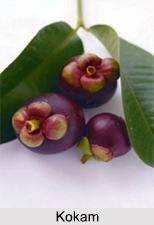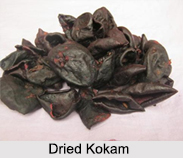 Kokam is better known for its edible fruits which is consumed as fruit and vegetable and when dry used as popular spice in the west coast of India. Kokam tree is also known as "Kokam Butter Tree", "Brindonia Tallow Tree", etc. It is a slender evergreen tree with drooping branches; leaves ovate or oblong lanceolate that are 6.25 to 8.75 cm long and 2.5 to 3.75 cm broad and appears dark green above and pale beneath. Fruits are globose or spherical with 2.5 to 3.75 cm diameter and are dark purple when ripe, enclosing 5 to 8 large seeds.
Kokam is better known for its edible fruits which is consumed as fruit and vegetable and when dry used as popular spice in the west coast of India. Kokam tree is also known as "Kokam Butter Tree", "Brindonia Tallow Tree", etc. It is a slender evergreen tree with drooping branches; leaves ovate or oblong lanceolate that are 6.25 to 8.75 cm long and 2.5 to 3.75 cm broad and appears dark green above and pale beneath. Fruits are globose or spherical with 2.5 to 3.75 cm diameter and are dark purple when ripe, enclosing 5 to 8 large seeds.
Etymology of Kokam
The Botanical name of Kokam is "Garcinia Indica Choisy" belonging to the "Guttiferae" family. It is also called "Kokam" in Hindi, Bengali and Punjabi; "Kokan" in Gujarati; "Murgala" in Kannada; "Punampulli" in Malayalam; "Amsol", "Katambi", "Ratamba" in Marathi and "Murgal" in Tamil.
Use of Kokam in Cuisine
The Kokam fruit has an agreeable flavour and a sweetish acid taste. The ripened, rind and juice of Kokam fruit are commonly used in cooking. The dried and salted rind is used as a condiment in curries. It is used in Konkan area chiefly in the form of Kokam prepared by drying the outer rind, soaking it repeatedly in the juice of the pulp and sun drying. It is used as a garnish to give an acid flavour to curries and also for preparing cooling syrups during summer.
 Use of Kokam in Medicine
Use of Kokam in Medicine
The fruit is anthelmintic and cardio tonic, and useful in piles, dysentery, tumors, pains and cardiac disorders. A syrup from the fruit juice is given in bilious affections. The root is astringent.
Kokam Butter
A valuable edible fat known in commerce as "Kokam butter" is extracted by crushing the kernels, boiling the pulp in water and skimming off the fat from the top; or by churning the crushed pulp with water.
Use of Kokam Butter
Kokam butter is considered nutritive, astringent, demulcent and emollient. It is suitable for ointments, suppositories and pharmaceutical purposes. It is used as a local application to ulcers and fissures of lips, hand, etc.
Kokam butter as sold in local markets consists of egg shaped lumps or cakes of light grey or yellowish colour with a greasy feel and a bland oily taste. It is used mainly as an edible fat. It is suitable for use as confectionery butter. It is also suitable for candle and soap making.




















